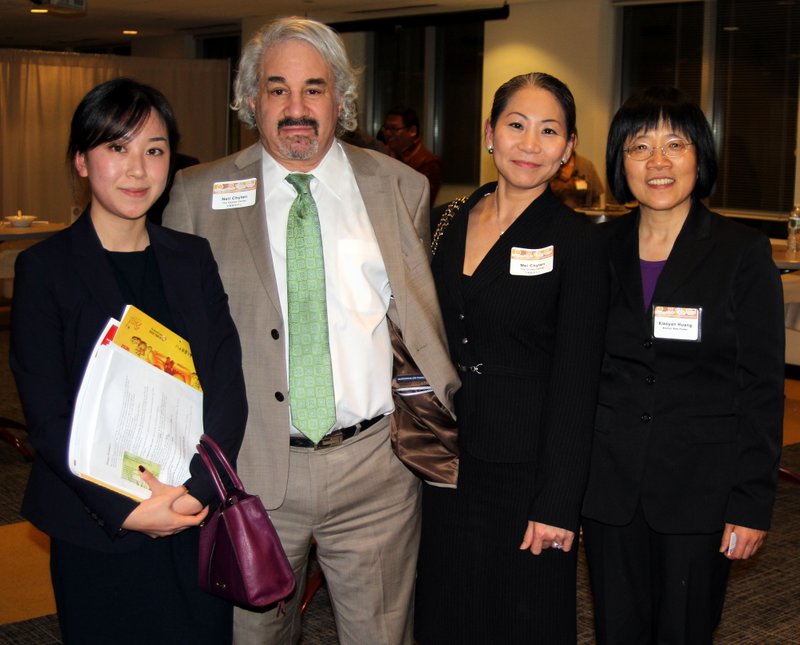By Neil Chyten
(Neil Chyten is the founder of the Chyten Center, and an author of many SAT, ACT and other test preparation books.)

(2nd and 3rd from left)Mr. and Mrs. Neil Cheyten at Wanjiaweb annual conference (provided to bostonese.com).
Content Change I: The content of the redesigned SAT draws heavily on strands of the Common Core State Standards.
Reason: The College Board, under the leadership of David Coleman, has repositioned the SAT as a test of Common Core strands, which collectively serve as the primary guide to education in American schools. This is also a strategic move aimed at disarming critics who have long felt the SAT was a tricky test, rather than a true assessment.
Content Change II: The redesigned SAT focuses on relevant words, the meanings of which depend on how they’re used.
Reason: The SAT Critical Reading section (formerly called SAT Verbal) has long been criticized for favoring test takers who memorize long lists of vocabulary words, many of which have no significant value beyond the test. In keeping with its alignment with the Common Core and focus on college and career readiness, the SAT now requires students to deduce word meanings from their context. As with previous incarnations, the SAT will continue to focus on words whose meanings change based on their context. For example, the word “champion” which we usually think of as a noun (a winner), often appears on the SAT as a verb (to fight for or support).
Content Change III: Like the Common Core, the redesigned SAT is cross disciplinary; it contains questions that test reading, writing, and math across diverse subjects such as science history, social studies and technology.
Reason: Blended learning has become a popular concept in American education since it more realistically represents situations found in college and careers. Rarely in these settings is someone merely asked to solve a math question, for example. It is far more likely that a person will face a situation in which the inherent math must be deduced and solved. Or, in reading a textbook chapter, one will encounter a graph or chart whose data must be extracted and analyzed. The SAT has changed its stripes to mirror this trend in the American education system.
Content Change IV: At least one reading passage draws from US founding documents and/or texts that draw from “the global conversation.”
Reason: This change has to do with making the SAT a test of “relevant” knowledge. The US founding documents, and texts that draw from global issues or events, have actual significance beyond the test. This is once again part of the “blended” nature of the SAT. Since these documents have historical and/or social import, the SAT tests analytical reading skills with passages having historical and social relevance.
Content Change V: Students must have strong reading, grammar and writing skills to master the redesigned SAT because questions on the test are largely passage based. Even many math questions are rooted in real life situations found in the form of word problems. The Essay requires students to analyze an author’s style, technique and strategy.
Reason: First, this change more closely aligns the SAT with the ACT, which favors strong readers. The ACT Science, Reading, and English Tests are all passage based and many ACT Math Test questions are in the form of word problems. Second, this change more closely aligns the SAT with Advanced Placement (AP) tests that are analytical in nature, requiring students to provide far more detail not only on subject-specific information but also on writer’s intention, style and technique.
Content Change VI: All types of questions feature content drawn from multiple content areas that students are likely to encounter in college and careers.
Reason: The SAT is largely designed to measure students’ success in mastering the new educational standards brought by the Common Core. One underlying principle of the Common Core is that students should be taught and tested on a wide variety of subjects that are reflective of situations that will enhance their readiness for college and careers.
Content Change VII: The Math test draws largely from Algebra and using algebra to solve or analyze “real life” problems.
Reason: The College Board rightfully considers algebra to be at the heart of real-world problem-solving skills, allowing individuals in college and careers to identify unknown qualities, and to predict and/or analyze trends and tendencies in any of a number of situations. Many SAT math questions require students to analyze situations and use appropriate mathematical modeling (algebra) to solve them.
Content Change VIII: The Essay section on the redesigned SAT asks students to read a passage and explain how the author builds an argument to persuade an audience. Students are asked to analyze the author’s use of evidence, reasoning, and stylistic and persuasive elements.
Reason: Past versions of the SAT allowed students to write about almost anything, and to practice embellishing essays in order to satisfy requirements that enabled them to earn high scores. This change requires students to use critical thinking skills to evaluate the essays for content, style and structure, just as they will be required to do in college.